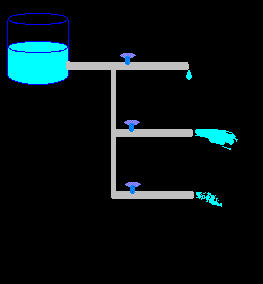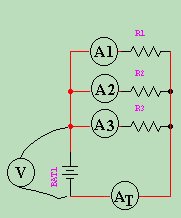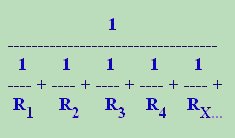


Parallel Circuits Notice that in the picture to the left, that there are 3 different paths which
the water can take. All 3 paths have the same incoming pressure, but the flow
of some paths can be more restricted than in others. Parallel circuits in
electronics work on the same principle. While there may be multiple paths for
the electricity to flow through, the electrical pressure (Voltage) remains the
same through all paths.
Notice that in the picture to the left, that there are 3 different paths which
the water can take. All 3 paths have the same incoming pressure, but the flow
of some paths can be more restricted than in others. Parallel circuits in
electronics work on the same principle. While there may be multiple paths for
the electricity to flow through, the electrical pressure (Voltage) remains the
same through all paths.

As you can see from the diagram on the right, there are 4 meters placed in this circuit to measure the current. The first 3, (A 1 , A 2 , and A 3 ) measure only the current flowing through that individual leg of the circuit. The 4th, A T measures the Total current of the circuit. If you take the three individual currents, and add them all together, they will equal the total current, measured on the 4th meter. From this we can see that the current in a parallel circuit is additive. 
Resistance in a parallel circuit can be quite a bit trickier than in a series circuit. It is found by " Reciprocating the Sum of the Reciprocals ". (huh?)Simple. Taking the reciprocal of a number means dividing "1" by that number. The reciprocal of 2 would be 1 divided by 2 or ½. Most modern calculators have a [1/X] button just for this purpose. So if you take the reciprocals of the values of all of the resistors, which would, of course, give you a bunch of fractions, and add them all up, then reciprocate their sum, you would have the answer. The formula would look something like this: 
Confused yet? Good.... let's see if we can clear it all up in lesson 13! |
| (On The Following Indicator... PURPLE will indicate your current location) | ||||||||||||||||||||||||
| 1 | 2 | 3 | 4 | 5 | 6 | 7 | 8 | 9 | 10 | 11 | 12 | 13 | 14 | 15 | 16 | 17 | 18 | 19 | 20 | 21 | 22 | 23 | 24 | 25 |
| 26 | 27 | 28 | 29 | 30 | 31 | 32 | 33 | 34 | 35 | 36 | 37 | 38 | 39 | 40 | 41 | 42 | 43 | 44 | 45 | 46 | 47 | 48 | 49 | 50 |
| 51 | 52 | 53 | 54 | 55 | 56 | 57 | 58 | 59 | 60 | 61 | 62 | 63 | 64 | 65 | 66 | 67 | 68 | 69 | 70 | 71 | 72 | 73 | 74 | 75 |
| Otherwise - please click to visit an advertiser so they know you saw their ad! |
